A Bibliometric and Visual Analysis of Global Urban Resilience Research in 2011–2020: Development and Hotspots
Abstract
:1. Introduction
2. Methods and Data
2.1. Methods
2.2. Data Sources
3. Results of Scientometric
3.1. Co-Citation Analysis
3.1.1. Co-Citation Journals
3.1.2. Co-Citation Document
3.2. Co-Word Analysis
3.2.1. Co-Occurring Keywords
3.2.2. Co-Occurring Subject Categories
3.3. Cooperation Analysis
3.3.1. Co-Authorship Network
3.3.2. Network of Institutions and Countries
3.4. Clusters Analysis
3.4.1. Keywords Clusters
3.4.2. Documents Co-Citation Clusters
4. Discussions
4.1. Research Topics
4.1.1. Urban Floods and Stormwater Management
4.1.2. Urban Ecosystem Services
4.1.3. Urban Landscapes
4.1.4. Trauma
4.2. Research Limitations
5. Conclusions
Author Contributions
Funding
Institutional Review Board Statement
Informed Consent Statement
Data Availability Statement
Conflicts of Interest
References
- Sharifi, A.; Pathak, M.; Joshi, C.; He, B.-J. A systematic review of the health co-benefits of urban climate change adaptation. Sustain. Cities Soc. 2021, 74, 103190. [Google Scholar] [CrossRef]
- Glaeser, E.L. Triumph of the city: How our greatest invention makes us richer, smarter, greener, healthier, and happier (an excerpt). J. Econ. Sociol. 2013, 14, 75–94. [Google Scholar] [CrossRef]
- Jabareen, Y. Planning the resilient city: Concepts and strategies for coping with climate change and environmental risk. Cities 2013, 31, 220–229. [Google Scholar] [CrossRef]
- Lam, N.S.-N.; Arenas, H.; Brito, P.L.; Liu, K.-B. Assessment of vulnerability and adaptive capacity to coastal hazards in the Caribbean Region. J. Coast. Res. 2014, 70, 473–478. [Google Scholar] [CrossRef]
- Yiwen, S.; Jiang, X. Understanding urban resilience: A conceptual analysis based on integrated international literature review. Urban Plan. Int. 2015, 30, 48–54. [Google Scholar]
- Godschalk, D.R. Urban hazard mitigation: Creating resilient cities. Nat. Hazards Rev. 2003, 4, 136–143. [Google Scholar] [CrossRef]
- Cimellaro, G.P. Urban Resilience for Emergency Response and Recovery; Springer: Berlin/Heidelberg, Germany, 2016. [Google Scholar]
- Jha, A.K.; Miner, T.W.; Stanton-Geddes, Z. Building Urban Resilience: Principles, Tools, and Practice; World Bank Publications: New York, NY, USA, 2013. [Google Scholar]
- Meerow, S.; Newell, J.P.; Stults, M. Defining urban resilience: A review. Landsc. Urban Plan. 2016, 147, 38–49. [Google Scholar] [CrossRef]
- Gomes Ribeiro, P.J.; Pena Jardim Goncalves, L.A. Urban resilience: A conceptual framework. Sustain. Cities Soc. 2019, 50, 101625. [Google Scholar] [CrossRef]
- Elmqvist, T.; Andersson, E.; Frantzeskaki, N.; McPhearson, T.; Olsson, P.; Gaffney, O.; Takeuchi, K.; Folke, C. Sustainability and resilience for transformation in the urban century. Nat. Sustain. 2019, 2, 267–273. [Google Scholar] [CrossRef]
- Chandler, D.; Coaffee, J. The Routledge Handbook of International Resilience; Taylor & Francis Group: London, UK; New York, NY, USA, 2016. [Google Scholar]
- Coaffee, J.; Therrien, M.C.; Chelleri, L.; Henstra, D.; Aldrich, D.P.; Mitchell, C.L.; Tsenkova, S.; Rigaud, É.; participants. Urban resilience implementation: A policy challenge and research agenda for the 21st century. J. Contingencies Crisis Manag. 2018, 26, 403–410. [Google Scholar] [CrossRef]
- Pelling, M.; Manuel-Navarrete, D. From Resilience to Transformation: The Adaptive Cycle in Two Mexican Urban Centers. Ecol. Soc. 2011, 16, 11. [Google Scholar] [CrossRef] [Green Version]
- Folke, C.; Carpenter, S.R.; Walker, B.; Scheffer, M.; Chapin, T.; Rockström, J. Resilience thinking: Integrating resilience, adaptability and transformability. Ecol. Soc. 2010, 15, 299–305. [Google Scholar] [CrossRef]
- Elmqvist, T. Urban resilience thinking. Solutions 2014, 5, 26–30. [Google Scholar]
- McPhearson, T.; Parnell, S.; Simon, D.; Gaffney, O.; Elmqvist, T.; Bai, X.; Roberts, D.; Revi, A. Scientists must have a say in the future of cities. Nat. News 2016, 538, 165–166. [Google Scholar] [CrossRef] [Green Version]
- Meng, C.; Du, X.; Ren, Y.; Shen, L.; Cheng, G.; Wang, J. Sustainable urban development: An examination of literature evolution on urban carrying capacity in the Chinese context. J. Clean. Prod. 2020, 277, 122802. [Google Scholar] [CrossRef]
- Kong, L.; Liu, Z.; Wu, J. A systematic review of big data-based urban sustainability research: State-of-the-science and future directions. J. Clean. Prod. 2020, 273, 123142. [Google Scholar] [CrossRef]
- Marvuglia, A.; Havinga, L.; Heidrich, O.; Fonseca, J.; Gaitani, N.; Reckien, D. Advances and challenges in assessing urban sustainability: An advanced bibliometric review. Renew. Sustain. Energy Rev. 2020, 124, 109788. [Google Scholar] [CrossRef]
- Zhao, L.; Tang, Z.-y.; Zou, X. Mapping the knowledge domain of smart-city research: A bibliometric and scientometric analysis. Sustainability 2019, 11, 6648. [Google Scholar] [CrossRef] [Green Version]
- Peponi, A.; Morgado, P. Smart and regenerative urban growth: A literature network analysis. Int. J. Environ. Res. Public Health 2020, 17, 2463. [Google Scholar] [CrossRef] [Green Version]
- Leal da Silva, L.B.; Alencar, M.H.; Almeida, A.T.d.A. Multidimensional flood risk management under climate changes: Bibliometric analysis, trends and strategic guidelines for decision-making in urban dynamics. Int. J. Disaster Risk Reduct. 2020, 50, 101865. [Google Scholar] [CrossRef]
- Wu, F.; Geng, Y.; Tian, X.; Zhong, S.; Wu, W.; Yu, S.; Xiao, S. Responding climate change: A bibliometric review on urban environmental governance. J. Clean. Prod. 2018, 204, 344–354. [Google Scholar] [CrossRef]
- Jiang, Y.; Hou, L.; Shi, T.; Gui, Q. A review of urban planning research for climate change. Sustainability 2017, 9, 2224. [Google Scholar] [CrossRef] [Green Version]
- Chen, C.; Ibekwe-SanJuan, F.; Hou, J. The structure and dynamics of cocitation clusters: A multiple-perspective cocitation analysis. J. Am. Soc. Inf. Sci. Technol. 2010, 61, 1386–1409. [Google Scholar] [CrossRef] [Green Version]
- Chen, C. CiteSpace II: Detecting and visualizing emerging trends and transient patterns in scientific literature. J. Am. Soc. Inf. Sci. Technol. 2006, 57, 359–377. [Google Scholar] [CrossRef] [Green Version]
- Small, H. Co-citation in the scientific literature: A new measure of the relationship between two documents. J. Am. Soc. Inf. Sci. 1973, 24, 265–269. [Google Scholar] [CrossRef]
- Web of Science (n.d.). Available online: http://apps.webofknowledge.com (accessed on 28 November 2020).
- He, B.-J.; Zhao, D.; Xiong, K.; Qi, J.; Ulpiani, G.; Pignatta, G.; Prasad, D.; Jones, P. A framework for addressing urban heat challenges and associated adaptive behavior by the public and the issue of willingness to pay for heat resilient infrastructure in Chongqing, China. Sustain. Cities Soc. 2021, 75, 103361. [Google Scholar] [CrossRef]
- Li, T.; Dong, Y.; Liu, Z. A review of social-ecological system resilience: Mechanism, assessment and management. Sci. Total Environ. 2020, 723, 138113. [Google Scholar] [CrossRef] [PubMed]
- Zhang, X.; Li, H. Urban resilience and urban sustainability: What we know and what do not know? Cities 2018, 72, 141–148. [Google Scholar] [CrossRef]
- Habitat III New Urban Agenda. Available online: https://habitat3.org/the-new-urban-agenda (accessed on 10 January 2021).
- United Nations Framework Convention on Climate Change. Available online: https://unfccc.int/files/essential_background/background_publications_htmlpdf/application/pdf/conveng.pdf (accessed on 12 January 2021).
- United Nations Sustainable Development Goals. Available online: https://www.un.org/sustainabledevelopment/zh/ (accessed on 4 February 2021).
- Tepper, F. Sendai Framework for Disaster Risk Reduction 2015–2030. Int. J. Disaster Risk Sci. 2015, 30, 9–10. [Google Scholar]
- Wu, K.; Shao, Z.; Sharifzadeh, M.; Chu, Z.; Qin, S. Analytical approach to estimating the influence of shotcrete hardening property on tunnel response. J. Eng. Mech. 2022, 148, 04021127. [Google Scholar] [CrossRef]
- Wu, K.; Shao, Z.; Qin, S.; Zhao, N.; Chu, Z. An Improved Nonlinear Creep Model for Rock Applied to Tunnel Displacement Prediction. Int. J. Appl. Mech. 2021, 13, 2150094. [Google Scholar] [CrossRef]
- Gomez-Baggethun, E.; Barton, D.N. Classifying and valuing ecosystem services for urban planning. Ecol. Econ. 2013, 86, 235–245. [Google Scholar] [CrossRef]
- Broto, V.C.; Bulkeley, H. A survey of urban climate change experiments in 100 cities. Glob. Environ. Change-Hum. Policy Dimens. 2013, 23, 92–102. [Google Scholar] [CrossRef] [PubMed] [Green Version]
- Ahern, J.; Cilliers, S.; Niemela, J. The concept of ecosystem services in adaptive urban planning and design: A framework for supporting innovation. Landsc. Urban Plan. 2014, 125, 254–259. [Google Scholar] [CrossRef] [Green Version]
- Barthelemy, M. Spatial networks. Phys. Rep. Rev. Sect. Phys. Lett. 2011, 499, 1–101. [Google Scholar] [CrossRef] [Green Version]
- Andersson, E.; Barthel, S.; Borgstrom, S.; Colding, J.; Elmqvist, T.; Folke, C.; Gren, A. Reconnecting Cities to the Biosphere: Stewardship of Green Infrastructure and Urban Ecosystem Services. Ambio 2014, 43, 445–453. [Google Scholar] [CrossRef] [PubMed] [Green Version]
- Barthel, S.; Isendahl, C. Urban gardens, agriculture, and water management: Sources of resilience for long-term food security in cities. Ecol. Econ. 2013, 86, 224–234. [Google Scholar] [CrossRef]
- Ahern, J. Urban landscape sustainability and resilience: The promise and challenges of integrating ecology with urban planning and design. Landsc. Ecol. 2013, 28, 1203–1212. [Google Scholar] [CrossRef]
- Hammond, M.J.; Chen, A.S.; Djordjevic, S.; Butler, D.; Mark, O. Urban flood impact assessment: A state-of-the-art review. Urban Water J. 2015, 12, 14–29. [Google Scholar] [CrossRef] [Green Version]
- Cao, W.; Fang, Z.; Hou, G.; Han, M.; Xu, X.; Dong, J.; Zheng, J. The psychological impact of the COVID-19 epidemic on college students in China. Psychiatry Res. 2020, 287, 112934. [Google Scholar] [CrossRef]
- McPhearson, T.; Pickett, S.T.A.; Grimm, N.B.; Niemela, J.; Alberti, M.; Elmqvist, T.; Weber, C.; Haase, D.; Breuste, J.; Qureshi, S. Advancing Urban Ecology toward a Science of Cities. Bioscience 2016, 66, 198–212. [Google Scholar] [CrossRef] [Green Version]
- House-Peters, L.A.; Chang, H. Urban water demand modeling: Review of concepts, methods, and organizing principles. Water Resour. Res. 2011, 47, W05401. [Google Scholar] [CrossRef] [Green Version]
- Ahern, J. From fail-safe to safe-to-fail: Sustainability and resilience in the new urban world. Landsc. Urban Plan. 2011, 100, 341–343. [Google Scholar] [CrossRef] [Green Version]
- Kabisch, N.; Frantzeskaki, N.; Pauleit, S.; Naumann, S.; Davis, M.; Artmann, M.; Haase, D.; Knapp, S.; Korn, H.; Stadler, J. Nature-based solutions to climate change mitigation and adaptation in urban areas: Perspectives on indicators, knowledge gaps, barriers, and opportunities for action. Ecol. Soc. 2016, 21, 39. [Google Scholar] [CrossRef] [Green Version]
- Gunawardena, K.R.; Wells, M.J.; Kershaw, T. Utilising green and bluespace to mitigate urban heat island intensity. Sci. Total Environ. 2017, 584, 1040–1055. [Google Scholar] [CrossRef]
- Sandifer, P.A.; Sutton-Grier, A.E.; Ward, B.P. Exploring connections among nature, biodiversity, ecosystem services, and human health and well-being: Opportunities to enhance health and biodiversity conservation. Ecosyst. Serv. 2015, 12, 1–15. [Google Scholar] [CrossRef] [Green Version]
- Schoennagel, T.; Balch, J.K.; Brenkert-Smith, H.; Dennison, P.E.; Harvey, B.J.; Krawchuk, M.A.; Mietkiewicz, N.; Morgan, P.; Moritz, M.A.; Rasker, R.; et al. Adapt to more wildfire in western North American forests as climate changes. Proc. Natl. Acad. Sci. USA 2017, 114, 4582–4590. [Google Scholar] [CrossRef] [Green Version]
- Wilby, R.L.; Keenan, R. Adapting to flood risk under climate change. Prog. Phys. Geogr. Earth Environ. 2012, 36, 348–378. [Google Scholar] [CrossRef]
- Hunt, A.; Watkiss, P. Climate change impacts and adaptation in cities: A review of the literature. Clim. Change 2011, 104, 13–49. [Google Scholar] [CrossRef] [Green Version]
- Meerow, S.; Newell, J.P. Spatial planning for multifunctional green infrastructure: Growing resilience in Detroit. Landsc. Urban Plan. 2017, 159, 62–75. [Google Scholar] [CrossRef]
- Evans, D.H.; Fletcher, R.J.; Pottier, C.; Chevance, J.B.; Soutif, D.; Tan, B.S.; Im, S.; Ea, D.; Tin, T.N.; Kim, S.; et al. Uncovering archaeological landscapes at Angkor using lidar. Proc. Natl. Acad. Sci. USA 2013, 110, 12595–12600. [Google Scholar] [CrossRef] [PubMed] [Green Version]
- Ouyang, M.; Duenas-Osorio, L.; Min, X. A three-stage resilience analysis framework for urban infrastructure systems. Struct. Saf. 2012, 36-37, 23–31. [Google Scholar] [CrossRef]
- Bendt, P.; Barthel, S.; Colding, J. Civic greening and environmental learning in public-access community gardens in Berlin. Landsc. Urban Plan. 2013, 109, 18–30. [Google Scholar] [CrossRef]
- Leichenko, R. Climate change and urban resilience. Curr. Opin. Environ. Sustain. 2011, 3, 164–168. [Google Scholar] [CrossRef]
- Ernstson, H. The social production of ecosystem services: A framework for studying environmental justice and ecological complexity in urbanized landscapes. Landsc. Urban Plan. 2013, 109, 7–17. [Google Scholar] [CrossRef] [Green Version]
- Lin, B.B.; Philpott, S.M.; Jha, S. The future of urban agriculture and biodiversity-ecosystem services: Challenges and next steps. Basic Appl. Ecol. 2015, 16, 189–201. [Google Scholar] [CrossRef]
- Lovell, S.T.; Taylor, J.R. Supplying urban ecosystem services through multifunctional green infrastructure in the United States. Landsc. Ecol. 2013, 28, 1447–1463. [Google Scholar] [CrossRef]
- Colding, J.; Barthel, S. The potential of ‘Urban Green Commons’ in the resilience building of cities. Ecol. Econ. 2013, 86, 156–166. [Google Scholar] [CrossRef]
- Liao, K.-H. A Theory on Urban Resilience to Floods-A Basis for Alternative Planning Practices. Ecol. Soc. 2012, 17, 388–395. [Google Scholar] [CrossRef]
- Colding, J.; Barthel, S.; Bendt, P.; Snep, R.; van der Knaap, W.; Ernstson, H. Urban green commons: Insights on urban common property systems. Glob. Environ. Change-Hum. Policy Dimens. 2013, 23, 1039–1051. [Google Scholar] [CrossRef]
- Hosseini, S.; Barker, K.; Ramirez-Marquez, J.E. A review of definitions and measures of system resilience. Reliab. Eng. Syst. Saf. 2016, 145, 47–61. [Google Scholar] [CrossRef]
- Fletcher, T.D.; Shuster, W.; Hunt, W.F.; Ashley, R.; Butler, D.; Arthur, S.; Trowsdale, S.; Barraud, S.; Semadeni-Davies, A.; Bertrand-Krajewski, J.-L. SUDS, LID, BMPs, WSUD and more–The evolution and application of terminology surrounding urban drainage. Urban Water J. 2015, 12, 525–542. [Google Scholar] [CrossRef]
- McPhearson, T.; Andersson, E.; Elmqvist, T.; Frantzeskaki, N. Resilience of and through urban ecosystem services. Ecosyst. Serv. 2015, 12, 152–156. [Google Scholar] [CrossRef]
- Wolch, J.R.; Byrne, J.; Newell, J.P. Urban green space, public health, and environmental justice: The challenge of making cities ‘just green enough’. Landsc. Urban Plan. 2014, 125, 234–244. [Google Scholar] [CrossRef] [Green Version]
- Edenhofer, O. Reforming emissions trading. Nat. Clim. Change 2014, 4, 663–664. [Google Scholar] [CrossRef]
- Barthel, S.; Folke, C.; Colding, J. Social–ecological memory in urban gardens—Retaining the capacity for management of ecosystem services. Glob. Environ. Change 2010, 20, 255–265. [Google Scholar] [CrossRef]
- Davoudi, S.; Shaw, K.; Haider, L.J.; Quinlan, A.E.; Peterson, G.D.; Wilkinson, C.; Fünfgeld, H.; Mcevoy, D.; Porter, L.; Davoudi, S. Resilience: A Bridging Concept or a Dead End? “Reframing” Resilience: Challenges for Planning Theory and Practice Interacting Traps: Resilience Assessment of a Pasture Management System in Northern Afghanistan Urban Resilience: What Does it Mean in Planning Practice? Resilience as a Useful Concept for Climate Change Adaptation? The Politics of Resilience for Planning: A Cautionary Note. Plan. Theory Pract. 2012, 13, 299–333. [Google Scholar]
- Chelleri, L.; Waters, J.J.; Olazabal, M.; Minucci, G. Resilience trade-offs: Addressing multiple scales and temporal aspects of urban resilience. Environ. Urban. 2015, 27, 181–198. [Google Scholar] [CrossRef] [Green Version]
- Mugume, S.N.; Gomez, D.E.; Fu, G.; Farmani, R.; Butler, D. A global analysis approach for investigating structural resilience in urban drainage systems. Water Res. 2015, 81, 15–26. [Google Scholar] [CrossRef] [Green Version]
- Masnavi, M.; Gharai, F.; Hajibandeh, M. Exploring urban resilience thinking for its application in urban planning: A review of literature. Int. J. Environ. Sci. Technol. 2019, 16, 567–582. [Google Scholar] [CrossRef]
- Katz, J.S.; Martin, B.R. What is Research Collaboration? Res. Policy 1997, 26, 1–18. [Google Scholar] [CrossRef]
- Zhao, D.; Zhao, X.; Khongnawang, T.; Arshad, M.; Triantafilis, J. A Vis-NIR Spectral Library to Predict Clay in Australian Cotton Growing Soil. Soil Sci. Soc. Am. J. 2018, 82, 1347–1357. [Google Scholar] [CrossRef]
- Chu, Z.; Wu, Z.; Wang, Z.; Weng, L.; Liu, Q.; Fan, L. Micro-mechanism of brittle creep in saturated sandstone and its mechanical behavior after creep damage. Int. J. Rock Mech. Min. Sci. 2022, 149, 104994. [Google Scholar] [CrossRef]
- Casal-Campos, A.; Fu, G.; Butler, D.; Moore, A. An Integrated Environmental Assessment of Green and Gray Infrastructure Strategies for Robust Decision Making. Environ. Sci. Technol. 2015, 49, 8307–8314. [Google Scholar] [CrossRef] [PubMed] [Green Version]
- Casal-Campos, A.; Sadr, S.; Fu, G.; Butler, D. Reliable, Resilient and Sustainable Urban Drainage Systems: An Analysis of Robustness under Deep Uncertainty. Environ. Ence Technol. 2018, 52, 9008–9021. [Google Scholar]
- Butler, D.; Farmani, R.; Fu, G.; Ward, S.; Diao, K.; Astaraie-Imani, M. A new approach to urban water management: Safe and sure. Procedia Eng. 2014, 89, 347–354. [Google Scholar] [CrossRef] [Green Version]
- Ward, S.; Butler, D. Rainwater harvesting and social networks: Visualising interactions for niche governance, resilience and sustainability. Water 2016, 8, 526. [Google Scholar] [CrossRef] [Green Version]
- Frantzeskaki, N.; van Steenbergen, F.; Stedman, R.C. Sense of place and experimentation in urban sustainability transitions: The Resilience Lab in Carnisse, Rotterdam, The Netherlands. Sustain. Sci. 2018, 13, 1045–1059. [Google Scholar] [CrossRef] [Green Version]
- Dumitru, A.; Frantzeskaki, N.; Collier, M. Identifying principles for the design of robust impact evaluation frameworks for nature-based solutions in cities. Environ. Sci. Policy 2020, 112, 107–116. [Google Scholar] [CrossRef]
- Li, J.; Chen, C. CiteSpace: Text Mining and Visualization in Scientific Literature; Capital University of Economics and Business Press: Beijing, China, 2016. [Google Scholar]
- Li, X.; Wu, P.; Shen, G.Q.; Wang, X.; Teng, Y. Mapping the knowledge domains of Building Information Modeling (BIM): A bibliometric approach. Autom. Constr. 2017, 84, 195–206. [Google Scholar] [CrossRef]
- Zhao, D.; Arshad, M.; Wang, J.; Triantafilis, J. Soil exchangeable cations estimation using Vis-NIR spectroscopy in different depths: Effects of multiple calibration models and spiking. Comput. Electron. Agric. 2021, 182, 105990. [Google Scholar] [CrossRef]
- Gotham, K.F.; Campanella, R. Coupled Vulnerability and Resilience: The Dynamics of Cross-Scale Interactions in Post-Katrina New Orleans. Ecol. Soc. 2011, 16, 63–64. [Google Scholar] [CrossRef] [Green Version]
- Garschagen, M. Resilience and organisational institutionalism from a cross-cultural perspective: An exploration based on urban climate change adaptation in Vietnam. Nat. Hazards 2013, 67, 25–46. [Google Scholar] [CrossRef]
- Johannessen, Å.; Wamsler, C. What does resilience mean for urban water services? Ecol. Soc. 2017, 22, 1. [Google Scholar] [CrossRef] [Green Version]
- Hale, J.D.; Sadler, J. Resilient ecological solutions for urban regeneration. Proc. Inst. Civ. Eng. Eng. Sustain. 2012, 165, 59–67. [Google Scholar] [CrossRef] [Green Version]
- Calkin, D.E.; Cohen, J.D.; Finney, M.A.; Thompson, M.P. How risk management can prevent future wildfire disasters in the wildland-urban interface. Proc. Natl. Acad. Sci. United States Am. 2014, 111, 746–751. [Google Scholar] [CrossRef] [Green Version]
- Ruan, J.; Chen, Y.; Yang, Z. Assessment of temporal and spatial progress of urban resilience in Guangzhou under rainstorm scenarios. Int. J. Disaster Risk Reduct. 2021, 66, 102578. [Google Scholar] [CrossRef]
- Kapucu, N.; Martín, Y.; Williamson, Z. Urban resilience for building a sustainable and safe environment. Urban Gov. 2021, in press. [CrossRef]
- Feng, M.; Ren, J.; He, J.; Chan, F.K.S.; Wu, C. Potency of the pandemic on air quality: An urban resilience perspective. Sci. Total Environ. 2022, 805, 150248. [Google Scholar] [CrossRef]
- Tress, B.; Tress, G.; Fry, G. Integrative studies on rural landscapes: Policy expectations and research practice. Landsc. Urban Plan. 2005, 70, 177–191. [Google Scholar] [CrossRef]
- Marcus, L.; Colding, J. Toward an integrated theory of spatial morphology and resilient urban systems. Ecol. Soc. 2014, 19, 55. [Google Scholar] [CrossRef] [Green Version]
- Manuel-Navarrete, D.; Pelling, M. Subjectivity and the politics of transformation in response to development and environmental change. Glob. Environ. Change 2015, 35, 558–569. [Google Scholar] [CrossRef] [Green Version]
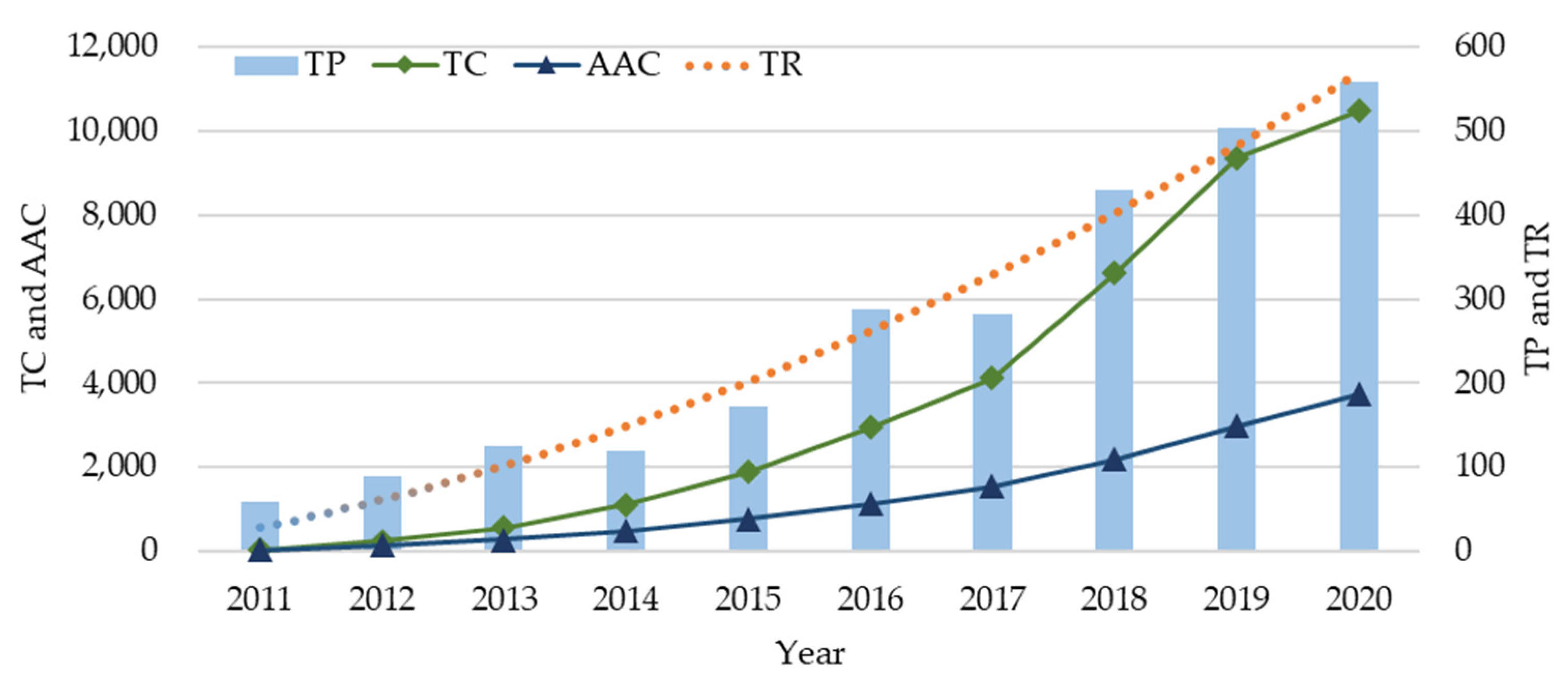
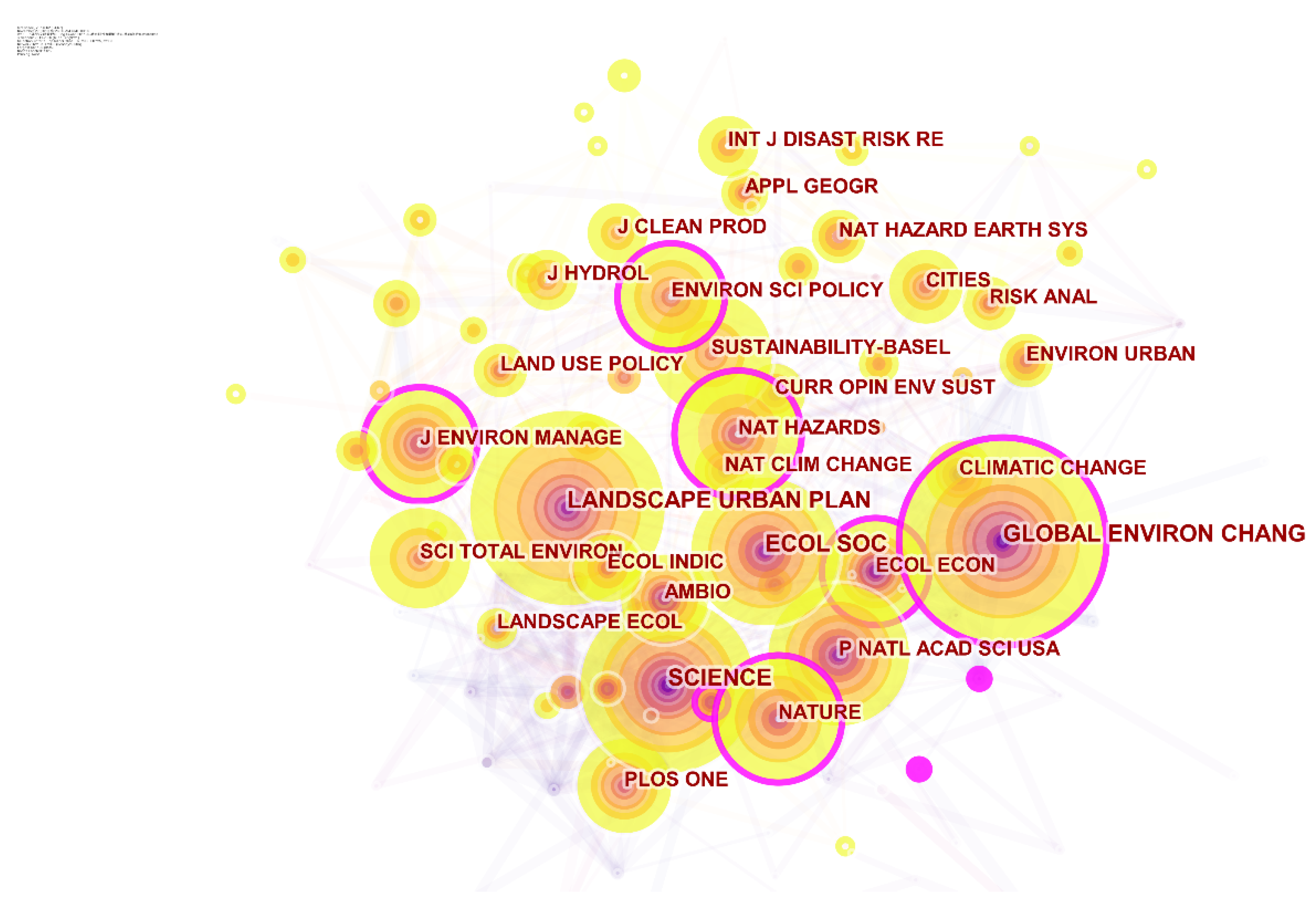
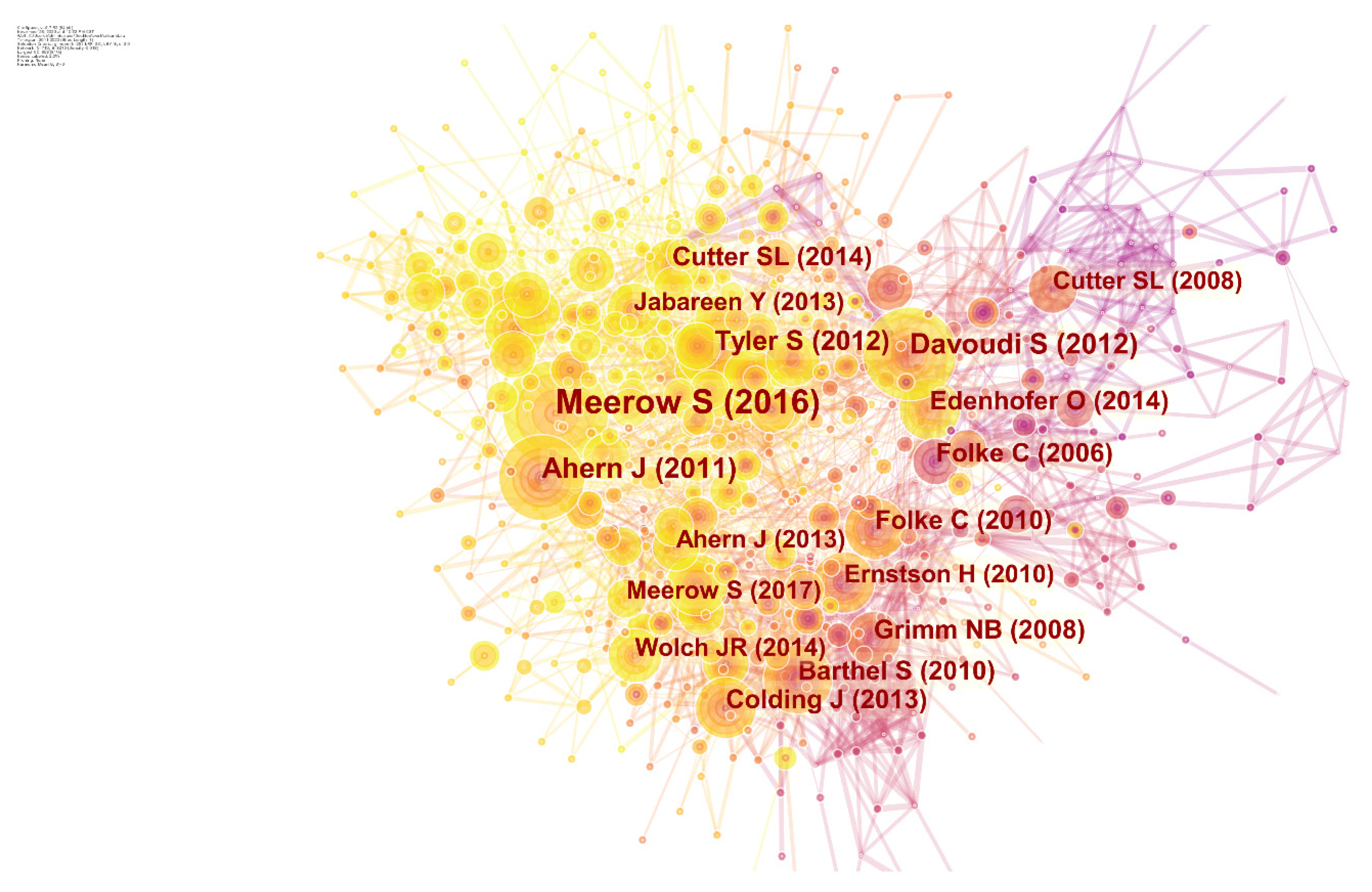
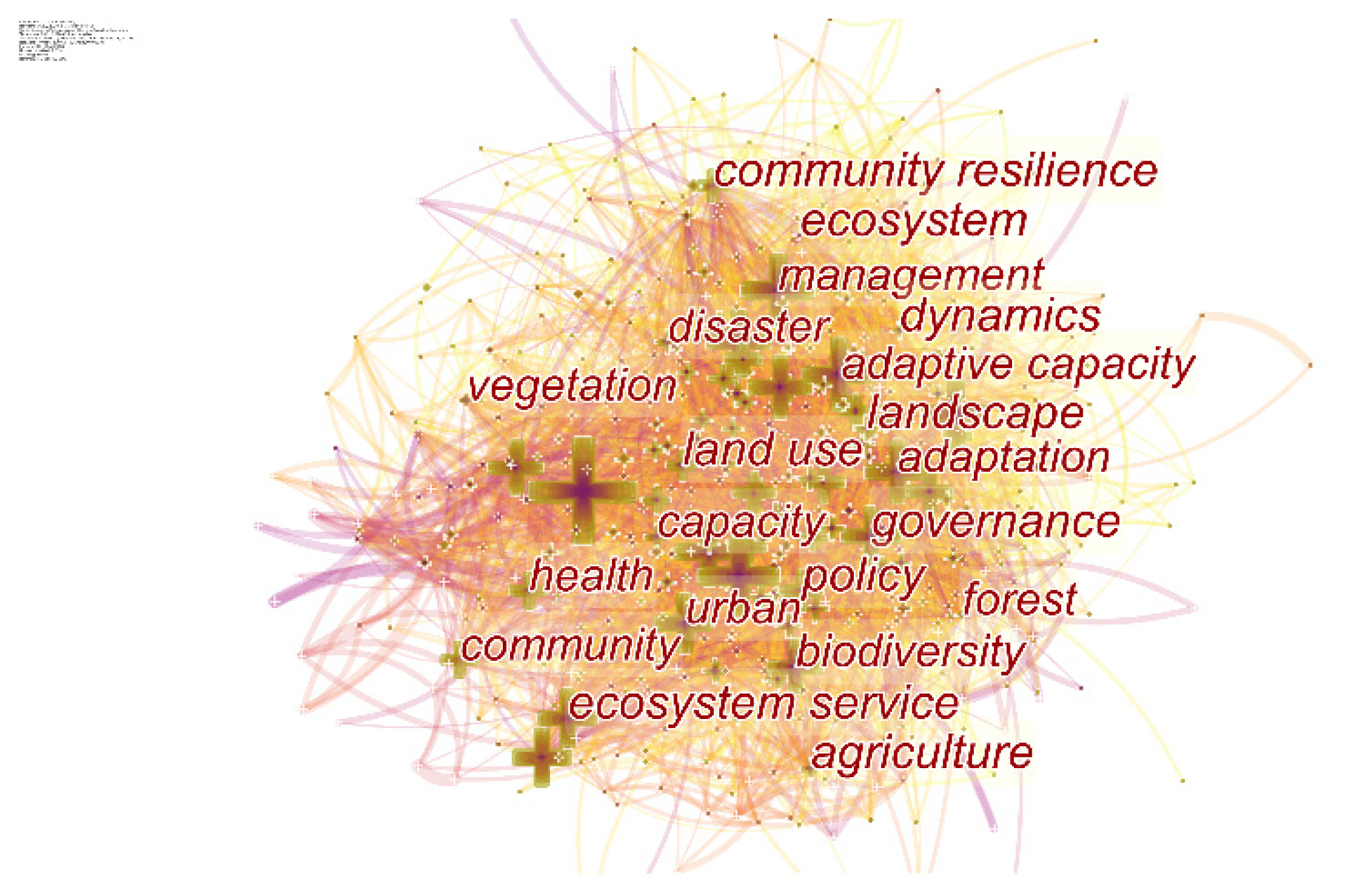
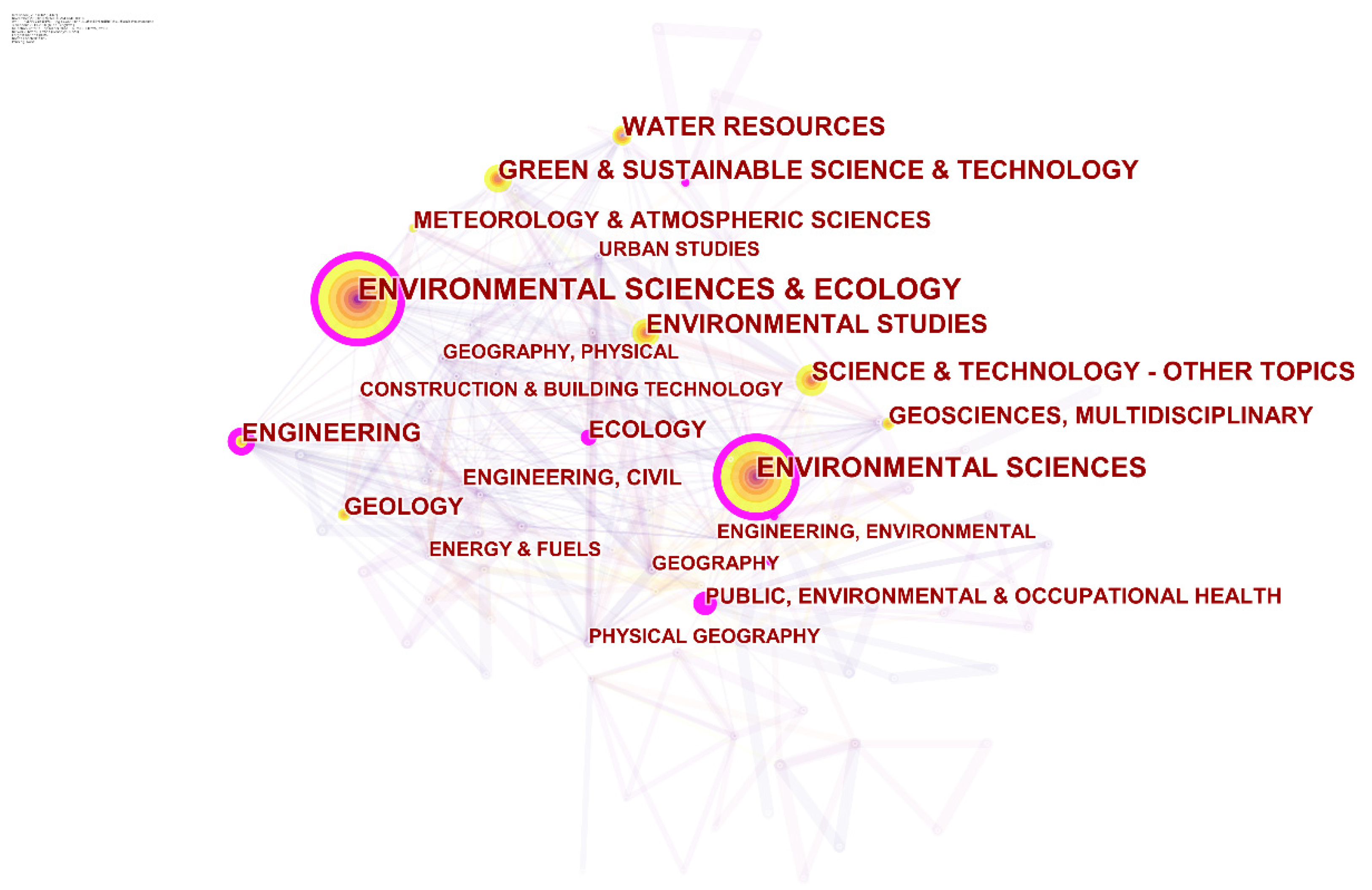
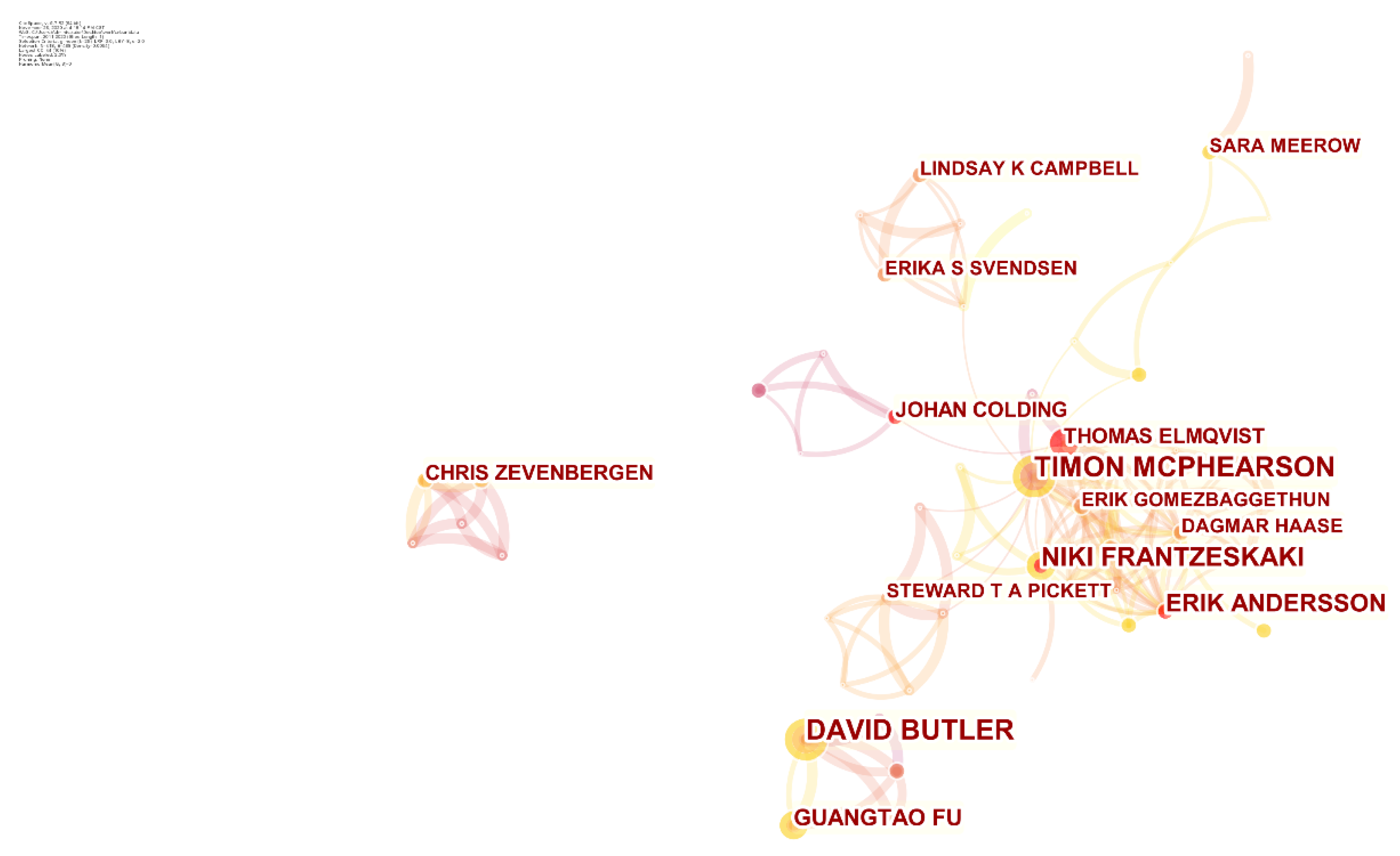
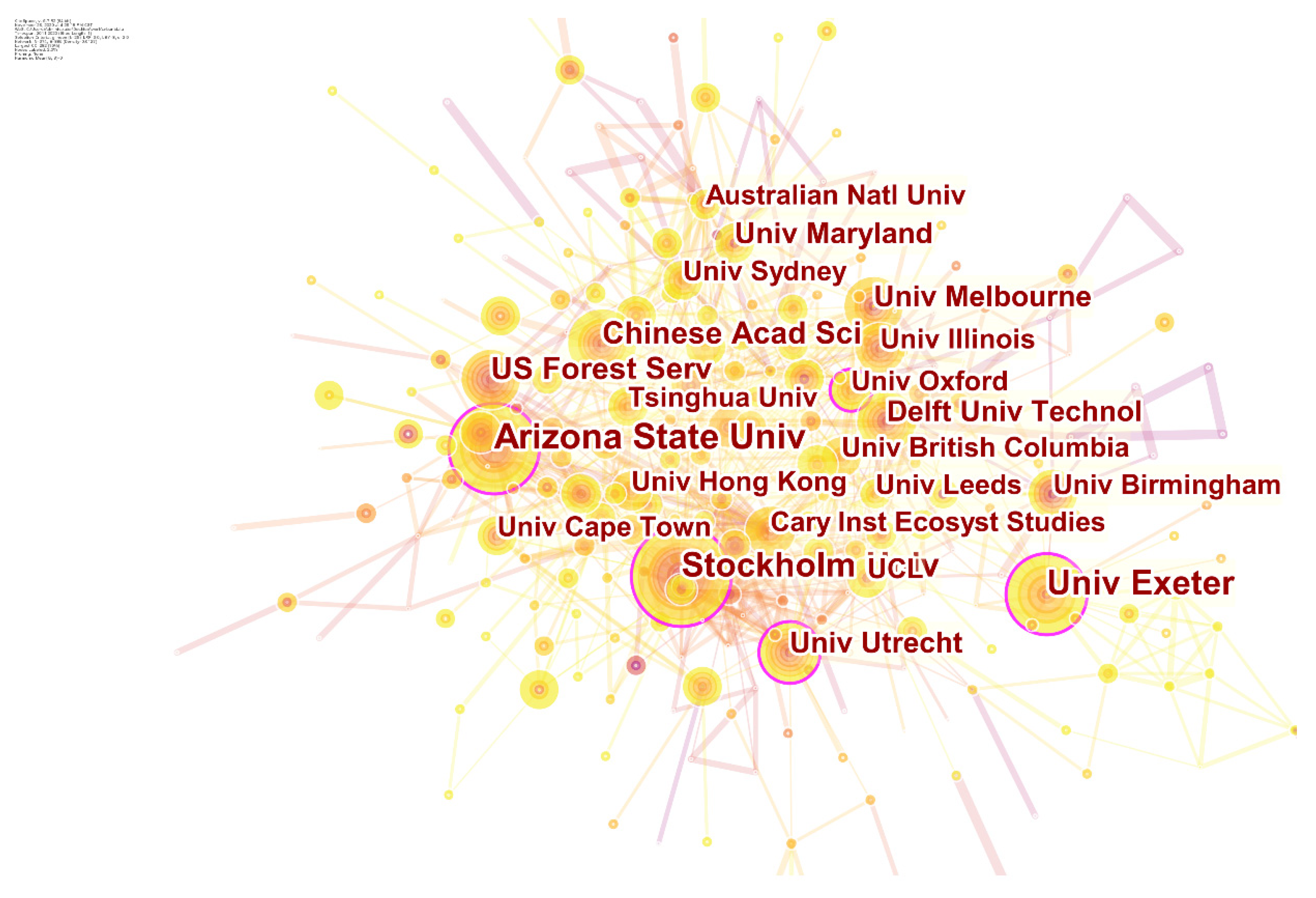
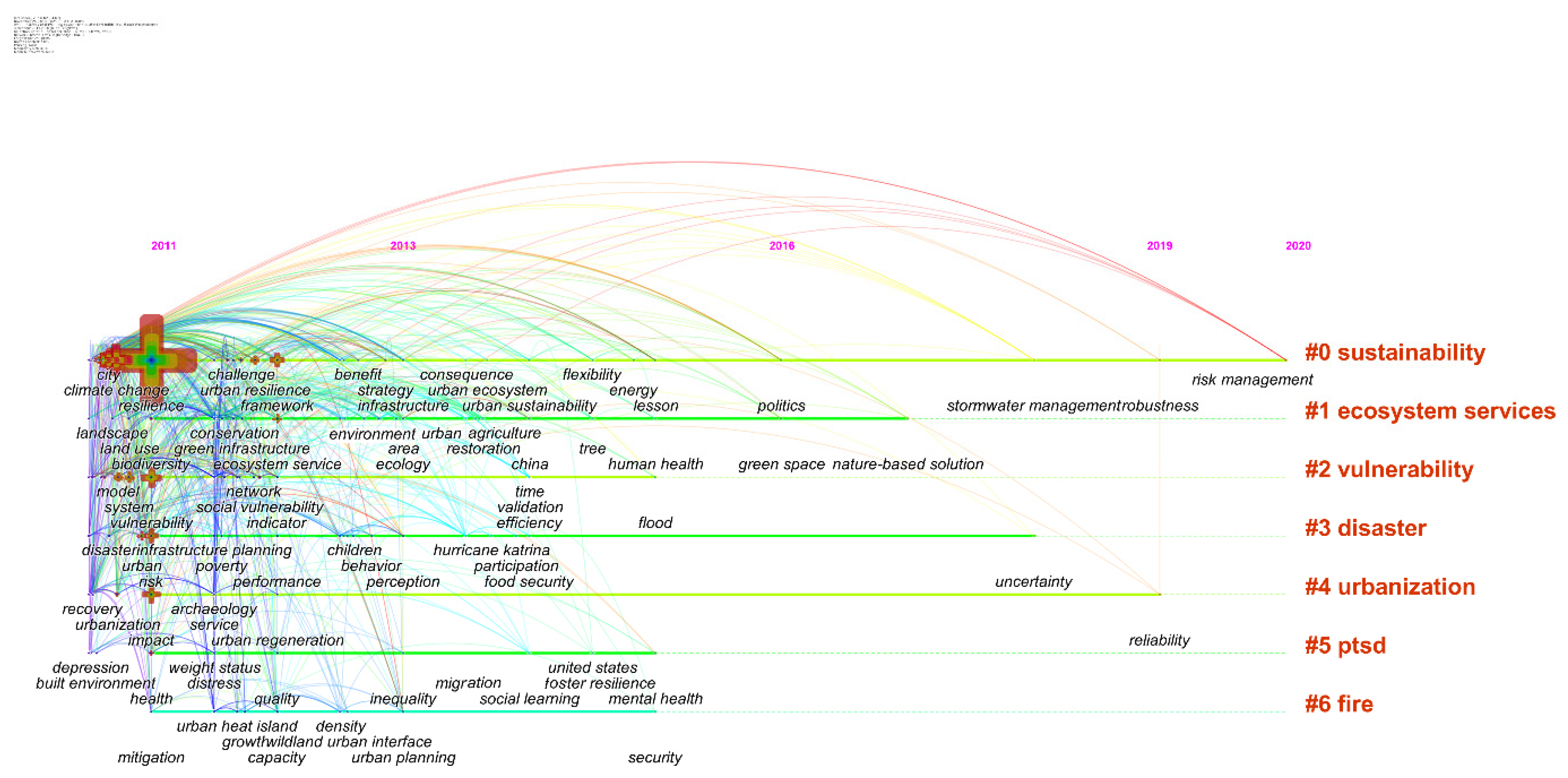
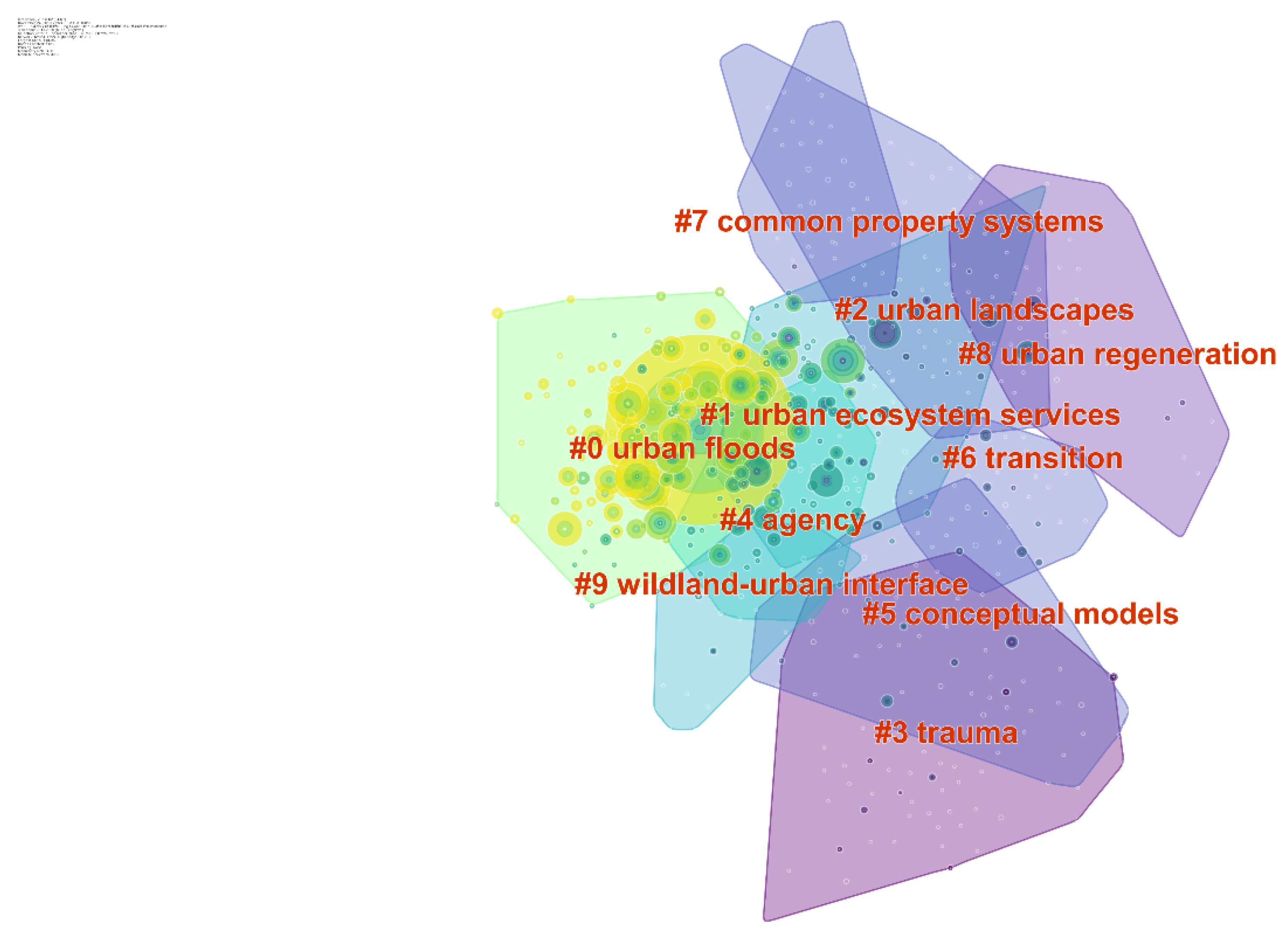
| Retrieval Mode | Publication Type | Year | Retrieval Results | Retrieval Time |
|---|---|---|---|---|
| TS = (“urban resilience”) | Article; review | 2011–2020 | 2629 | 20 November 2020 |
| Journal | Count | Percentage (%) | IF | Publisher | Host Country |
|---|---|---|---|---|---|
| Sustainability | 287 | 10.9 | 2.576 | MDPI | Switzerland |
| International Journal of Disaster Risk Reduction | 94 | 3.57 | 2.896 | Elsevier Ltd. | The Netherlands |
| Landscape and Urban Planning | 61 | 2.317 | 5.441 | Elsevier Science BV | The Netherlands |
| Sustainable Cities and Society | 61 | 2.317 | 5.268 | Elsevier | The Netherlands |
| Science of the Total Environment | 60 | 2.279 | 6.551 | Elsevier Science BV | The Netherlands |
| Natural Hazards | 58 | 2.203 | 2.427 | Springer Nature | USA |
| Water | 58 | 2.203 | 2.544 | MDPI | Switzerland |
| Ecology and Society | 49 | 1.861 | 3.890 | The Resilience Alliance | Canada |
| Journal of Cleaner Production | 46 | 1.747 | 7.246 | Elsevier Ltd. | USA |
| Environmental Science & Policy | 45 | 1.709 | 4.767 | Elsevier Science BV | USA |
| International Journal of Environmental Research and Public Health | 40 | 1.519 | 2.849 | MDPI | Switzerland |
| Urban Forestry & Urban Greening | 40 | 1.519 | 4.021 | Elsevier GMBH | Germany |
| PLOS ONE | 34 | 1.291 | 2.74 | Public Library of Science | USA |
| Journal of Environmental Management | 27 | 1.025 | 5.647 | Academic Press Inc | UK |
| Urban Ecosystems | 25 | 0.949 | 2.547 | Kluwer Academic Publishers | USA |
| Current Opinion in Environmental Sustainability | 24 | 0.912 | 5.658 | Elsevier | UK |
| Natural Hazards and Earth System Sciences | 24 | 0.912 | 3.102 | European Geosciences Union | Germany |
| Ecological Indicators | 23 | 0.874 | 4.229 | Elsevier | The Netherlands |
| Climatic Change | 22 | 0.836 | 4.134 | Springer Netherlands | The Netherlands |
| Global Environmental Change Human and Policy Dimensions | 22 | 0.836 | 10.466 | Elsevier Ltd. | UK |
| Journal of Flood Risk Management | 21 | 0.798 | 3.066 | Blackwell Publishing | UK |
| Building Research and Information | 20 | 0.76 | 3.887 | Taylor and Francis Ltd. | UK |
| Ecosystem Services | 19 | 0.722 | 6.33 | Elsevier BV | The Netherlands |
| Water Resources Management | 19 | 0.722 | 2.924 | Springer Netherlands | The Netherlands |
| Regional Environmental Change | 17 | 0.646 | 3.481 | Springer Verlag | Germany |
| S/N | Article | Total Citations | S/N | Article | Total Citations | S/N | Article | Total Citations |
|---|---|---|---|---|---|---|---|---|
| 1 | Barthelemy 2011 [42] | 1099 | 11 | Andersson, Barthel et al., 2014 [43] | 211 | 21 | Barthel and Isendahl 2013 [44] | 162 |
| 2 | Gomez-Baggethun and Barton 2013 [39] | 566 | 12 | Ahern 2013 [45] | 210 | 22 | Hammond, Chen et al., 2015 [46] | 157 |
| 3 | Meerow, Newell et al., 2016 [9] | 430 | 13 | Cao, Fang et al., 2020 [47] | 209 | 23 | McPhearson, Pickett et al., 2016 [48] | 155 |
| 4 | Broto and Bulkeley 2013 [40] | 391 | 14 | House-Peters and Chang 2011 [49] | 185 | 24 | Ahern, Cilliers et al., 2014 [41] | 150 |
| 5 | Ahern 2011 [50] | 336 | 15 | Kabisch, Frantzeskaki et al., 2016 [51] | 179 | 25 | Gunawardena, Wells et al., 2017 [52] | 145 |
| 6 | Sandifer, Sutton-Grier et al., 2015 [53] | 320 | 16 | Schoennagel, Balch et al., 2017 [54] | 176 | 26 | Wilby and Keenan 2012 [55] | 143 |
| 7 | Hunt and Watkiss 2011 [56] | 316 | 17 | Meerow and Newell 2017 [57] | 175 | 27 | Evans, Fletcher et al., 2013 [58] | 139 |
| 8 | Ouyang, Duenas-Osorio et al., 2012 [59] | 279 | 18 | Pelling and Manuel-Navarrete 2011 [14] | 174 | 28 | Bendt, Barthel et al., 2013 [60] | 136 |
| 9 | Leichenko 2011 [61] | 236 | 19 | Ernstson 2013 [62] | 171 | 29 | Lin, Philpott et al., 2015 [63] | 134 |
| 10 | Lovell and Taylor 2013 [64] | 228 | 20 | Colding and Barthel 2013 [65] | 162 | 30 | Liao 2012 [66] | 133 |
| S/N | Keywords | Burst Strength | Span | S/N | Keywords | Burst Strength | Span |
|---|---|---|---|---|---|---|---|
| 1 | Social-ecological system | 13.62 | 2011–2016 | 11 | Resource | 4.21 | 2012–2013 |
| 2 | Diversity | 11.56 | 2012–2016 | 12 | Stress | 4.09 | 2013–2014 |
| 3 | Capacity | 8.73 | 2012–2017 | 13 | PTSD | 3.80 | 2011–2012 |
| 4 | Growth | 8.25 | 2012–2015 | 14 | Stream | 3.80 | 2011–2012 |
| 5 | Ecosystem | 7.76 | 2012–2015 | 15 | Depression | 3.65 | 2011–2014 |
| 6 | Built environment | 6.28 | 2011–2016 | 16 | Community garden | 3.50 | 2013–2014 |
| 7 | Knowledge | 5.58 | 2011–2016 | 17 | Poverty | 3.27 | 2012–2014 |
| 8 | Forest | 4.85 | 2012–2015 | 18 | Pattern | 3.27 | 2013–2014 |
| 9 | Transition | 4.65 | 2011–2013 | 19 | Future | 3.01 | 2012–2013 |
| 10 | Biodiversity conservation | 4.21 | 2012–2013 | 20 | Urban heat island | 2.97 | 2012–2013 |
| Authors | Institution | Country | Counts | h-Index |
|---|---|---|---|---|
| David Butler | University of Exeter | UK | 23 | 39 |
| Timon McPhearson | New School, Urban Ecol Lab | USA | 21 | 18 |
| Niki Frantzeskaki | Erasmus University | The Netherlands | 18 | 30 |
| Sara Borgstrom | Stockholm University | Sweden | 15 | 14 |
| Thomas Elmqvist | Stockholm University | Sweden | 15 | 48 |
| Yan Wang | Virginia Polytechnic Institute & State University | USA | 14 | 5 |
| Chris Zevenbergen | Delft University of Technology | The Netherlands | 14 | 17 |
| Erik Andersson | Stockholm University | Sweden | 13 | 23 |
| Raziyeh Farmani | University of Exeter | UK | 11 | 23 |
| Guangtao Fu | University of Exeter | UK | 11 | 28 |
| Yangfan Li | Xiamen University | China | 11 | 14 |
| Berry Gersonius | IHE Delft Institute for Water Education | The Netherlands | 10 | 11 |
| Marcelo Gomes Miguez | Universidade Federal do Rio de Janeiro | Brazil | 10 | 3 |
| Steward Pickett | Cary Institute of Ecosystem Studies | USA | 10 | 47 |
| Christopher DF Rogers | Birmingham Ctr Resilience Research & Education | UK | 10 | 22 |
| Damien Serre | Avignon Université | France | 10 | 9 |
| Rank | Institution | Country | TP | Percent (%) |
|---|---|---|---|---|
| 1 | Arizona State University | USA | 121 | 4.442 |
| 2 | University of California System | USA | 78 | 2.863 |
| 3 | University of London | UK | 62 | 2.276 |
| 4 | Stockholm University | Sweden | 52 | 1.909 |
| 5 | State University System of Florida | USA | 51 | 1.872 |
| 6 | University of Exeter | UK | 47 | 1.725 |
| 7 | United States Department of Agriculture | USA | 41 | 1.505 |
| 8 | United States Forest Service | USA | 39 | 1.432 |
| 9 | Chinese Academy of Sciences | China | 38 | 1.395 |
| 10 | Wageningen University & Research | The Netherlands | 36 | 1.322 |
| Cluster ID | Size | Silhouette | Cluster Label (LLR) | Alternative Label | Mean Year | Representative Documents |
|---|---|---|---|---|---|---|
| #0 | 108 | 0.806 | Urban floods | Urban floods; stormwater management | 2015 | [66] |
| #1 | 76 | 0.746 | Urban ecosystem services | Urban ecosystem services; ecosystem services | 2012 | [70] |
| #2 | 56 | 0.747 | Urban landscapes | Urban landscapes; urban ecosystems | 2010 | [45] |
| #3 | 56 | 0.929 | Trauma | Trauma; regime shifts | 2007 | [90] |
| #4 | 42 | 0.832 | Agency | Agency; ecosystem services | 2012 | [91] |
| #5 | 48 | 0.775 | Conceptual models | Conceptual models; public health administration | 2009 | [10] |
| #6 | 41 | 0.903 | Transition | Transition; urban water | 2010 | [92] |
| #7 | 41 | 0.950 | Common property systems | Common property systems; Patagonia | 2009 | [67] |
| #8 | 39 | 0.916 | Urban regeneration | Urban regeneration; water supply | 2009 | [93] |
| #9 | 144 | 0.958 | Wildland-urban interface | Wildland-urban interface; wildfire | 2012 | [94] |
Publisher’s Note: MDPI stays neutral with regard to jurisdictional claims in published maps and institutional affiliations. |
© 2021 by the authors. Licensee MDPI, Basel, Switzerland. This article is an open access article distributed under the terms and conditions of the Creative Commons Attribution (CC BY) license (https://creativecommons.org/licenses/by/4.0/).
Share and Cite
Guo, P.; Li, Q.; Guo, H.; Li, H.; Yang, L. A Bibliometric and Visual Analysis of Global Urban Resilience Research in 2011–2020: Development and Hotspots. Sustainability 2022, 14, 229. https://doi.org/10.3390/su14010229
Guo P, Li Q, Guo H, Li H, Yang L. A Bibliometric and Visual Analysis of Global Urban Resilience Research in 2011–2020: Development and Hotspots. Sustainability. 2022; 14(1):229. https://doi.org/10.3390/su14010229
Chicago/Turabian StyleGuo, Ping, Qin Li, Haidong Guo, Huimin Li, and Lingbo Yang. 2022. "A Bibliometric and Visual Analysis of Global Urban Resilience Research in 2011–2020: Development and Hotspots" Sustainability 14, no. 1: 229. https://doi.org/10.3390/su14010229
APA StyleGuo, P., Li, Q., Guo, H., Li, H., & Yang, L. (2022). A Bibliometric and Visual Analysis of Global Urban Resilience Research in 2011–2020: Development and Hotspots. Sustainability, 14(1), 229. https://doi.org/10.3390/su14010229







